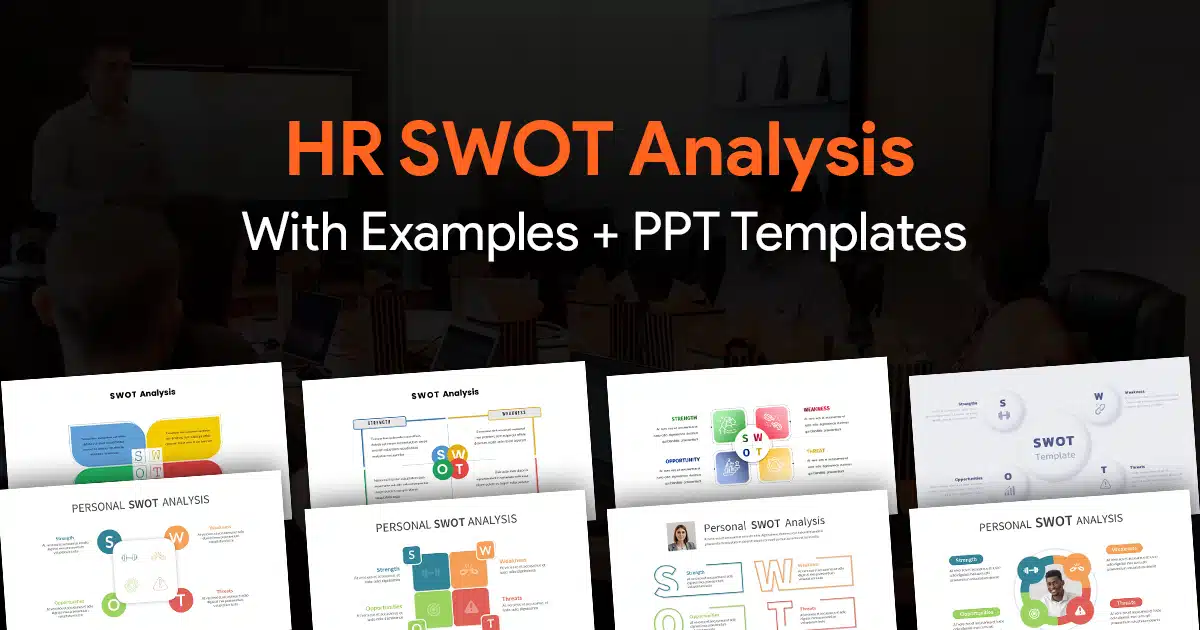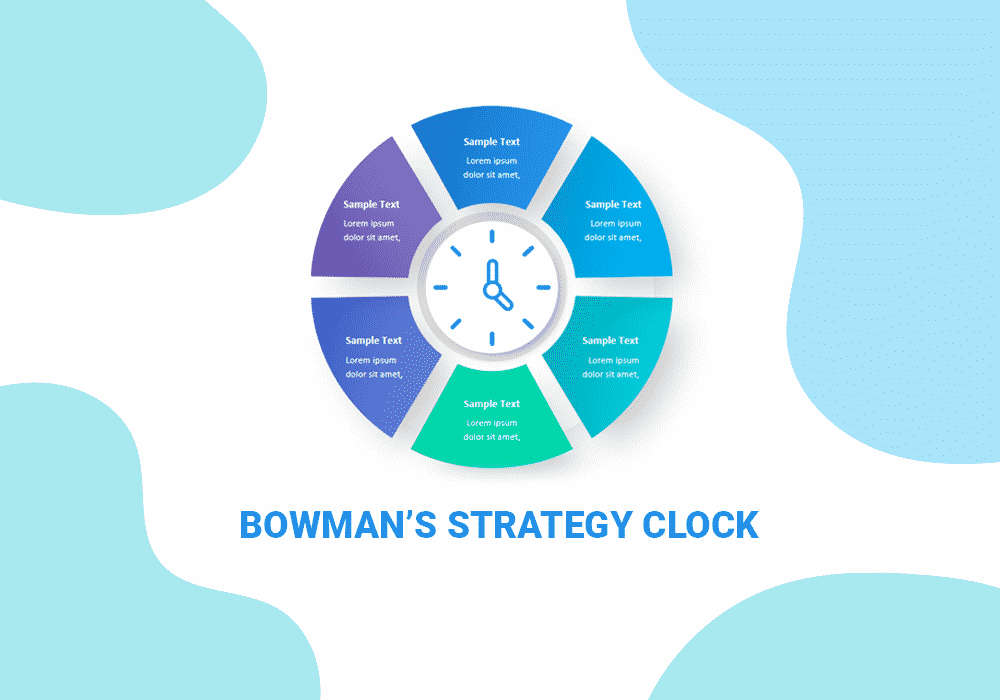HR SWOT Analysis, Examples + PPT Templates

What is HR SWOT analysis?
A SWOT analysis is a study conducted by an organization to recognize its strengths and weaknesses and the relevant opportunities and threats it faces. It is a planning technique that helps them to improve on their weaknesses, mitigate risk, leverage opportunities available, and enhance their strengths to achieve growth.
However, it is not limited to organizations alone; this can be conducted for departments within an organization and even individuals. Let’s look at HR SWOT analysis and have a look at our collection of SWOT analysis template PowerPoint. Also, check out our blog on SWOT analysis in healthcare.
This study will help you identify what needs to be improved upon, rectified, and so on.
How to Conduct an HR SWOT Analysis
Your HR SWOT analysis should be based on actual data and not guesswork or estimates. It is important to know how the data should be used to improve the HR processes or department and employee performance.
The first step in conducting the SWOT analysis is creating a chart or matrix with the four categories namely Strengths, Weaknesses, Opportunities, and Threats – make four quadrants, in other words. Hold a brainstorming session with your employees to get proper information about your internal strengths and weaknesses. Thorough research will give you the requisite data regarding external threats and opportunities. Important metrics must be set and measured, which will give you data about the success of your HR strategy and the department.
Some KPIs are turnover rate, retention rate, dismissal rate, duration in a particular designation, average recruitment time, cost per hire, employee productivity, and so on.
In each slot, list out the factors backed by figures, graphs, or pictures wherever possible. You now have an overall picture of your HR department.
You need to be meticulous and thorough when you carry out an HR SWOT analysis, so be prepared with as much data as you can gather.
Important points:
- Remember to focus on what is important; eliminate irrelevant details
- Consider quantifiable factors as much as possible
- Avoid guesswork
- SWOT analysis is teamwork; include everyone who can give you valid insights
Once you have listed the factors, evaluate: what will you do about them? For example:
- How to use your strengths to leverage opportunities in the market
- How to use opportunities to eliminate weaknesses
- How you can use strengths to mitigate threats
Strengths, Weaknesses, Opportunities, and Threats of HR
Let’s now look at some Guide on HR swot analysis examples:
Strengths of HR
Technology Use
Technology has ensured that cumbersome and time-consuming tasks are now streamlined, saving time significantly and improving operational efficiency. A prime example is recruitment platforms on the web where you can hire the right talent. Several HR software solutions and apps are available that help in handling the day-to-day functions and extend the scope of HR activities, thereby increasing overall productivity.
Protecting Employee Rights
Employees everywhere are concerned about protecting their rights; despite regulations and laws, employees still face discrimination based on gender, religion, ethnicity, and color at work. HR managers have a duty to protect employee rights; this helps to reinforce the bond between employees and the organization, leading to higher productivity.
Cooperation with HR
When the HR team and the rest of the employees are on good terms, it bodes well for the organization. Employees are happy, management is happy, and productivity increases.
Excellent Employment Branding Strategy
This is a great HR swot analysis example. The HR department of a company may have a compelling recruitment strategy that makes prospective candidates want to work there. Of course, this won’t happen overnight; it may take a couple of years of trial and error for the team to figure out what exactly employees look for in a company.
Compensation Package
A remuneration package that is comparable to the best in the industry and is commensurate with the skills and dedication of the employee makes for happy employees. The HR department that strives to work out the ideal package for the employees is a big strength to the organization, as it can ensure employee retention.
Low Turnover Rate
The turnover rate refers to the number of employees who quit in a given time period. A low turnover rate means that employees are happy and are not leaving their jobs. Attrition is never a good sign. But if employees are being retained, it is an indication that the HR department is doing a good job of communicating with them, protecting their rights, and keeping them satisfied at work.
Weaknesses of HR
Biased mindset
The HR department recruits the type of staff the organization requires, and they have the right to terminate employment for valid reasons. The HR department thus wields a lot of power; if any of the team members are biased, and they terminate or desist from hiring a particular employee due to personal bias or prejudice, it can harm the productivity of the business. They may also hire incompetent persons to do them personal favours.
Poor Reputation
Some companies may have a poor reputation in the market; in such a case, prospective candidates will be hesitant about joining the organization. If a company is known as a poor pay-master, or has a reputation for unfavourable contract terms and so on, they are unlikely to get the best talent in the market.
Unmotivated Employees
If employees are disinterested in their work and just get through the day somehow, it is a big negative point for the company’s HR department. It means that they are unhappy in their jobs as their interests are not being looked after well.
Limited Budget
The HR department has to assign resources in a manner that enhances productivity. However, if the company has a tight budget, this task can become very difficult for the HR department. Conducting operations like appraisals and training can become almost impossible, and this can lead to employee dissatisfaction.
Opportunities of HR
HR Policies
The HR department can work on updating its policies with a view to enhancing overall employee satisfaction and productivity. By carrying out meticulous research, the HR team can come up with strategic measures to achieve this objective.
Skilled Labour
With everyone realizing the importance of education and skilling, there are numerous educational and vocational training institutes emerging everywhere. This means higher availability of trained labor in the market. This is an opportunity for human resources managers to hire skilled and trained professionals to take the company on the path of growth.
Tech Advancement
Technological advancements have penetrated every industry, sector, and business function, and this includes human resources as well. The HR management can adopt technology to improve organizational efficiency. For example, productivity can be improved with AI, virtual reality, and machine learning have limitless opportunities. They can ensure employees become well-versed in these by arranging for proper training. This can give a competitive advantage to the company.
Threats to HR
Cyber Attacks
While technology has improved life for HR managers, the threat of cyber attacks like ransomware, phishing, trojans, etc. looms large. Sensitive employee information can be stolen and used by malicious people for wrong purposes. The HR department has to be extra careful about data privacy and protection.
Demand for Employees
There is a huge demand for skilled and experienced professionals, and other companies may poach your employees. They may offer better remuneration, benefits, working conditions, and so on. This means that the HR department has to be very careful to make sure that their best employees are well looked after; else, they stand to lose them to other companies.
What are the Benefits of Conducting an HR SWOT analysis?
It gives a complete overview of internal and external factors that impact the human resources of an organization. You can evaluate these factors, and improve on your weaknesses, build on your strengths, work at mitigating threats, and know which direction to take to leverage the opportunities available.
To Sum Up
The results of an HR SWOT analysis must be utilized to establish, improve, or alter HR strategy, ensuring that it is in line with the goals and mission of the organization. Improved HR strategy can lead to better recruitment processes hiring better professionals, and thereby improving the overall productivity and efficiency of the employees and the organization as a whole.



